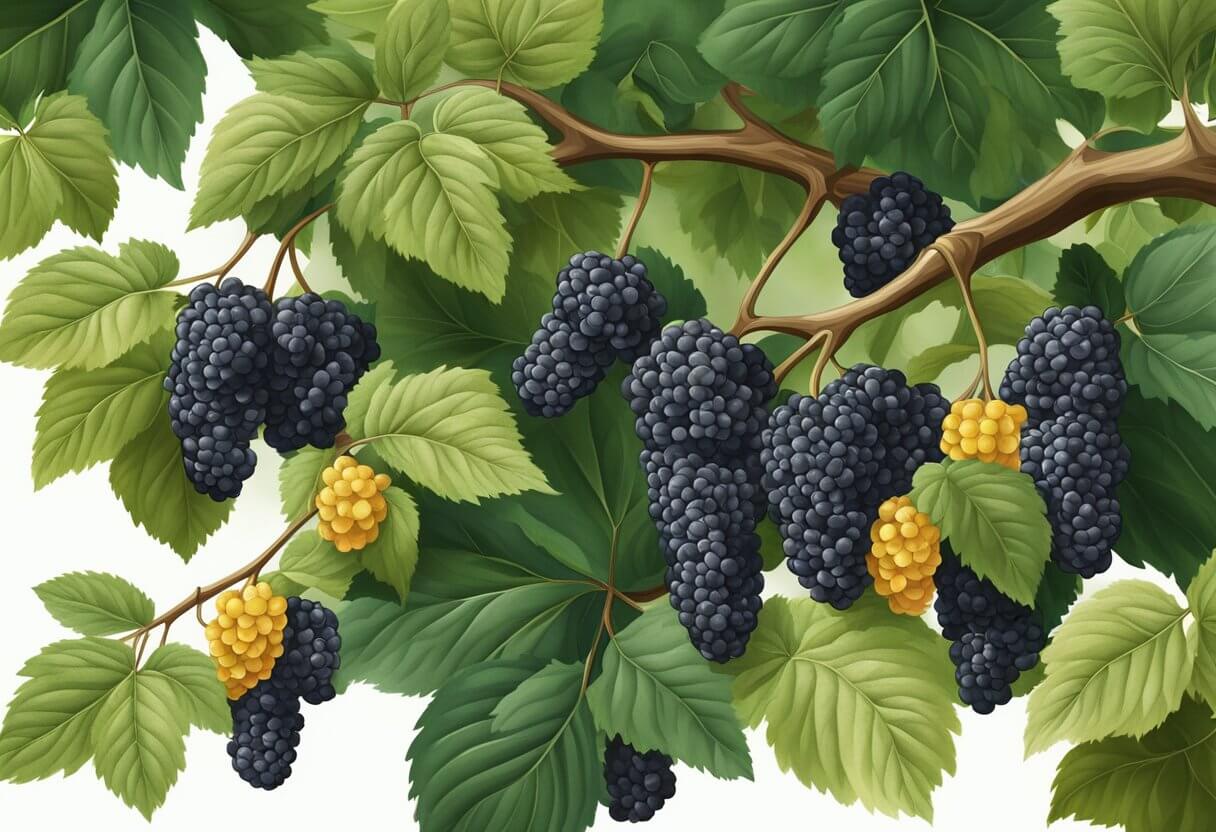Why Are Mulberry Trees Illegal? The Controversy Explained

Have you ever plucked a ripe, juicy mulberry off a tree and enjoyed its sweet flavor? These versatile trees produce tasty fruits that can be used to make jams, pies, even wine. Mulberry trees also serve as a vital food source for silkworms to produce silk. So with both culinary and economic benefits, why on earth would mulberry trees ever be illegal?
Are mulberry trees illegal? The short answer is sometimes. Certain regions have banned planting new mulberry trees due to their messy fruits, invasive roots, and extreme pollen production. But they are not classified as illegal everywhere. This article will uncover the facts around mulberry trees being restricted in certain areas.
We’ll explore questions like:
- What is it about mulberries that causes issues?
- Which states specifically have made them illegal?
- Should you remove a mulberry tree on your property?
- Are there still benefits to keeping mulberries around?
Let’s dig into the debate on the controversial mulberry!
What Exactly is a Mulberry Tree?
Before examining why mulberry trees face bans, it helps to understand what they are.
Mulberry is the common name used for multiple species of deciduous trees within the Morus genus. There are over 150 types of mulberries globally, with the most prominent being:
- White mulberry (Morus alba) – native to China
- Black mulberry (Morus nigra) – native to Southwestern Asia
- Red mulberry ([[mulberry tree|Morus rubra]]) – native to Eastern North America
These deciduous trees thrive in temperate, subtropical and tropical regions of Asia, Africa, Europe, and the Americas. They can grow over 30-80 feet tall.
The trees produce edible fruits resembling long, clustered berries. They can be red, black, purple, pink, or white when ripe.
But it’s the white mulberry species that stirs up most issues, which we’ll cover next.
The Unique Role of Mulberries in Silk Production
An interesting fact about mulberries – the leaves are the sole food source of silkworms. And silkworms produce silk cocoons that can be unraveled and woven into luxurious silk fabric.
This discovery originated in ancient China over 5,000 years ago. The practice quickly spread along the Silk Road trade route from East Asia to Europe. Silk became extremely valuable and desired across territories and cultures.
Even today, silk remains a multi-billion dollar global industry. And it all relies on the white mulberry as the staple food to raise silkworms.
So while mulberry groves were cultivated to feed mass silk production, the messy trees also managed to escape into natural habitats. Which brings us to…
Invasive Qualities Lead to Mulberry Bans
Here’s where our fruitful mulberry trees start causing trouble. As the white mulberry is non-native to North America, it possesses invasive qualities that allow it to easily colonize new ecosystems.
For starters, white mulberry trees are fast-growing – they can shoot up over 40 feet high rather quickly. They also spread aggressively by birds and wildlife consuming the berries and spreading the seeds everywhere through droppings.
In this manner, white mulberries can take over fields and forests, choking out native plant species. Interbreeding also occurs with the native red mulberry, diluting genetics.
By the late 1980’s, uncontrolled white mulberry thickets were creating enough of an ecological impact that measures were taken to stop them. Which states spearheaded the bans?
Which States Have Banned Mulberries?

Decades back, several municipalities in Southwest and Western states implemented bans against planting new white mulberry trees, including:
- Tucson, Arizona – banned white mulberry trees in 1984
- Las Vegas, Nevada – illegal to plant white mulberries since 1991
- El Paso, Texas – prohibited all new mulberry trees in 1992
Other areas also followed suit in restricting white mulberries from being grown due to their rampant wild spreading. Homeowners with existing mulberry trees were grandfathered in. But rules were put in place to try halting further invasion.
Partly fueling the bans was also extreme allergic reactions some people seemed to develop from prolific mulberry pollen.
Are Mulberries Considered Poisonous Plants?
This is a common question surrounding mulberry trees. And the answer is not definitive.
Ripe mulberry fruit is perfectly edible and rather tasty. In fact, ancient Chinese medicine promotes mulberries as beneficial for protecting against cancer, heart disease, diabetes and more.
However, unripe fruits and other mulberry tree parts like leaves and stems contain milky latex sap. This sap can irritate skin and cause stomach issues if eaten.
So white mulberry sap is mildly toxic, especially to kids and pets ingesting it. Plus birds tend to spread seeds from unripe fruits, propagating more nuisance mulberry shoots.
Beyond potential poisoning dangers, mulberry detractors loathe the huge mess created by dropping fruits and pollen production.
Extreme Pollen Causes Issues for Allergy Sufferers
For allergy prone individuals, mulberry flowering season can be misery. Mulberry trees emit copious amounts of pollen that cause harsh hayfever reactions.
The pollen also coats surfaces. Combine this with excessive juicy berries splattering everywhere, and you can imagine the nuisance.
These staining, allergy-triggering issues likely factored into areas with prior mulberry planting bans.
Let’s explore the next reason cities don’t want white mulberries running rampant.
Excessive Mess From Fruit Drips a Problem for Cities
Arching mulberry branches loaded with ripening fruit become heavy enough that they hang low. When the berries inevitably drop, they splatter surfaces below with purple-red juice stains.
These stains can be very difficult to remove from sidewalks, driveways, parked cars, and even building walls. For city municipalities, the cleanup headache and costs added up over time.
Homeowners also tire of mulberry stains, along with excess bird and wildlife feeding frenzies when fruits start falling.
Speaking of wildlife nuisances, shallow mulberry roots present infrastructure issues too.
Damage to Infrastructure From Shallow Mulberry Roots

A notorious trait of mulberry tree root systems is that they stay near the soil surface while spreading aggressively outward. Combine this with the tree’s fast growth rate and you have property damage waiting to happen.
White mulberry roots infiltrate tiny cracks seeking moisture. Over time, they can dislodge walkways, tear up underground pipes, and even undermine building foundations. Eventually costly repairs are needed.
So invasive surface roots are another legit beef cities have against uncontrolled mulberry growth. But one camp argues they don’t deserve the ‘invasive’ label as a tree species.
The Debate Around Classifying Them as Invasive Species
Not all experts agree that mulberries should be demonized and banned carte blanche. Some counter that:
- Many other common landscaping trees also spread easily beyond intended borders and boundaries.
- Mulberry’s ecological impact is mild compared to notoriously damaging exotic plants like kudzu vine or purple loosestrife.
- With wildlife relying on mulberry as a vital food source, removing trees hurts ecosystems.
Defenders contend that white mulberry’s benefits outweigh the negatives. So rather than eliminating existing mulberry trees, better solutions involve:
- Careful placement away from walkways, buildings, etc.
- Timely pruning for shape and to minimize overhanging branches.
- Swift clean-up of fallen plant debris.
- Seeking male mulberry trees which do not bear messy fruits.
So where does this leave homeowners wondering what to do about their backyard mulberry?
Should You Consider Planting a Mulberry Or Seek Alternatives?

If you live where white mulberries are prohibited, you’ll have no choice but to pick a different type of fruiting ornamental tree.
However, red mulberry and black mulberry species are still perfectly legal. Just ensure your local climate suits whichever mulberry variety you select.
If you already have an existing mulberry that predates any bans, carefully consider its placement and prune aggressively to control shape and size. Protect buildings from invasive roots as needed.
When sites appropriately, mulberry trees can provide food and shelter to area wildlife. Their flowers also draw pollinators while helping fruit sets on nearby plants.
Are There Benefits to Having Mulberry Trees Around?
Given the right location and management, mulberry trees offer tasty fruit, lovely shade, and valuable ecosystem services.
The sweet berry-like fruits can be eaten straight from the tree once fully ripe. They also make refreshing drinks, jams, desserts and fermented wine.
Mulberry’s dense, low-branched form casts cooling shade. The beautiful leaves turn bright yellow in fall.
And we can’t forget the ecological importance of mulberries as a caterpillar and butterfly host plant, plus food for birds and mammals.
Finally, established mulberry stands generate woody biomass that’s excellent for carving, furniture-making and even constructing houses. The wood easily planes, sands, turns and finishes.
Conclusion
In summary, white mulberry trees face occasional bans because:
- They readily colonize native ecosystems.
- Shallow roots damage infrastructure over time.
- Copious messy fruits and staining juice are nuisance.
- Highly allergenic pollen during flowering season.
However, others argue mulberries aren’t truly invasive plants warranting eradication. Careful placement and management may suffice.
And while restricted in spots, mulberry trees still hold ecological, culinary and wood-product value. Their shade and fruit also benefit backyard habitats.
So rather than asking “why are mulberry trees illegal”, a better question is “where can they legally be planted?” Check your local codes for guidance.
I hope this explanation helps clarify the debate around restricting mulberry trees! Let us know in comments your thoughts or experiences with managing mulberries.






